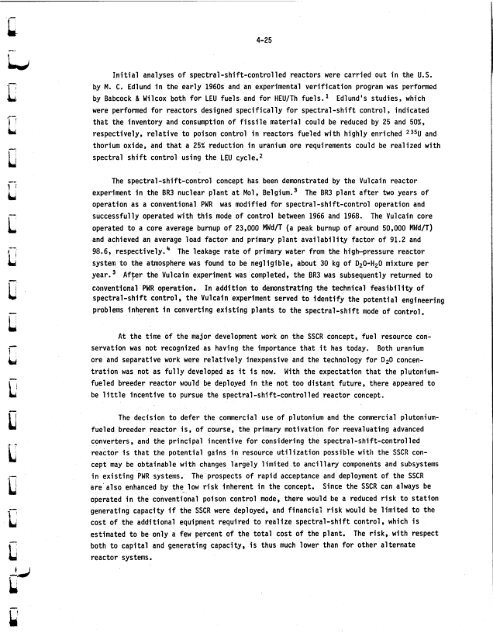ORNL-5388 - the Molten Salt Energy Technologies Web Site
ORNL-5388 - the Molten Salt Energy Technologies Web Site
ORNL-5388 - the Molten Salt Energy Technologies Web Site
You also want an ePaper? Increase the reach of your titles
YUMPU automatically turns print PDFs into web optimized ePapers that Google loves.
4-25<br />
Initial analyses of spectral-shift-controlled reactors were carried out in <strong>the</strong> U.S.<br />
by M. C. Edlund in <strong>the</strong> early 1960s and an experimental verification program was performed<br />
by Babcock & Wilcox both for LEU fuels and for HEU/Th fuels.' Edlund's studies, which<br />
were performed for reactors designed specifically for spectral-shift control, indicated<br />
that <strong>the</strong> inventory and consumption of fissile material could be reduced by 25 and 50%,<br />
respectively, relative to poison control in reactors fueled with highly enriched 235U and<br />
thorium oxide, and that a 25% reduction in uranium ore requirements could be realized with<br />
spectral shift control using <strong>the</strong> LEU cycle.2<br />
The spectral-shift-control concept has been demonstrated by <strong>the</strong> Vulcain reactor<br />
experiment in <strong>the</strong> BR3 nuclear plant at Mol, Belgi~m.~ The BR3 plant after two years of<br />
operation as a conventional PWR was modified for spectral -shift-control operation and<br />
successfully operated with this mode of control between 1966 and 1968. The Vulcain core<br />
operated to a core average burnup of 23,000 MWT (a peak burnup of around 50,000 MWd/T)<br />
and achieved an average load factor and primary plant availability factor of 91.2 and<br />
98.6, re~pectively.~ The leakage rate of primary water from <strong>the</strong> high-pressure reactor<br />
system to <strong>the</strong> atmosphere was found to be negligible, about 30 kg of D20-H20 mixture per<br />
year.3 AfFer <strong>the</strong> Vulcain experiment was completed, <strong>the</strong> BR3 was subsequently returned to<br />
conventional PWR operation. In addition to demonstrating <strong>the</strong> technical feasibility of<br />
spectral-shift control, <strong>the</strong> Vulcain experiment served to identify <strong>the</strong> potential engineering<br />
problems inherent in converting existing plants to <strong>the</strong> spectral-shift mode of control.<br />
At <strong>the</strong> time of <strong>the</strong> major development work on <strong>the</strong> SSCR concept, fuel resource con-<br />
servation was not recognized as having <strong>the</strong> importance that it has today. Both uranium<br />
ore and separative work were relatively inexpensive and <strong>the</strong> technology for D20 concen-<br />
tration was not as fully developed as it is now. With <strong>the</strong> expectation that <strong>the</strong> plutonium-<br />
fueled breeder reactor would be deployed in <strong>the</strong> not too distant future, <strong>the</strong>re appeared to<br />
be little incentive to pursue <strong>the</strong> spectral-shift-controlled reactor concept.<br />
The decision to defer <strong>the</strong> commercial use of plutonium and <strong>the</strong> commercial plutonium-<br />
fueled breeder reactor is, of course, <strong>the</strong> primary motivation for reevaluating advanced<br />
converters, and <strong>the</strong> principal incentive for considering <strong>the</strong> spectral-shift-controlled<br />
reactor is that <strong>the</strong> potential gains in resource utilization possible with <strong>the</strong> SSCR con-<br />
cept may be obtainable with changes largely limited to ancillary components and subsystems<br />
in existing PWR systems. The prospects of rapid acceptance and deployment of <strong>the</strong> SSCR<br />
are'also enhanced by <strong>the</strong> low risk inherent in <strong>the</strong> concept. Since <strong>the</strong> SSCR can always be<br />
operated in <strong>the</strong> conventional poison control mode, <strong>the</strong>re would be a reduced risk to station<br />
generating capacity if <strong>the</strong> SSCR were deployed, and financisi risk would be limited to <strong>the</strong><br />
cost of <strong>the</strong> additional equipment required to realize spectral-shift control, which is<br />
estimated to be only a few percent of <strong>the</strong> total cost of <strong>the</strong> plant. The risk, with respect<br />
both to capital and generating capacity, is thus much lower than for o<strong>the</strong>r alternate<br />
reactor systems.<br />
~



![Review of Molten Salt Reactor Physics Calculations [Disc 2]](https://img.yumpu.com/21979492/1/190x247/review-of-molten-salt-reactor-physics-calculations-disc-2.jpg?quality=85)












